Translate this page into:
Mutation analysis in three Chinese pedigrees with palmoplantar keratoderma caused by SERPINB7 gene mutations
Corresponding author: Dr. Jianwen Han, Department of Dermatology, The Affiliated Hospital of Inner Mongolia Medical University, Hohhot, Inner Mongolia, China. hanjianwen1981@hotmail.com
-
Received: ,
Accepted: ,
How to cite this article: Han H, Li J, Cao Y, Han C, Li X, Zhang Y, et al. Mutation analysis in three Chinese pedigrees with palmoplantar keratoderma caused by SERPINB7 gene mutations. Indian J Dermatol Venereol Leprol. doi: 10.25259/IJDVL_1062_2024
Dear Editor,
Palmoplantar keratoderma (PPK) encompasses a group of keratinising skin disorders characterised by excessive thickening of the epidermis in the palmoplantar regions which may be inherited or acquired. Nagashima-type palmoplantar keratoderma (NPPK, OMIM 615598) is an autosomal recessive variant of PPK.1 It is primarily characterised by well-demarcated, transgradient erythema and hyperkeratosis affecting the palms and soles.
Four patients presented at our outpatient department with complaints of rough palms and soles. Their demographic and clinical features are summarised in Table 1. There was no history of consanguinity [Figure S1]. This report summarises the clinical manifestations [Figure 1a-d and Figure S2], dermoscopic findings [Figure S3] and genetic mutations of these four patients from three Chinese pedigrees with NPPK, in order to elucidate the aetiology at the molecular level and provide guidance for future treatment of NPPK.
| Pedigree ID | Sex | Mutations in SERPINB7 gene | Zygosity | Age at diagnosis | Affected areas | Symptoms | Dermoscopic manifestations |
|---|---|---|---|---|---|---|---|
| Pedigree 1-The proband (Ⅱ-1) | Female | c.796C>T (p.R266X) | Homozygote | 3.5 years | Palms, soles, dorsal feet | Transgradient erythema, hyperkeratosis, scales, hyperhidrosis | Significant scales peeling off on palms |
| Pedigree 1-The proband’s younger sister (Ⅱ-2) | Female | c.796C>T (p.R266X) | Homozygote | 3.5 years | Palms, soles, dorsal feet | Transgradient erythema, hyperkeratosis, scales, hyperhidrosis | Partial disappearance of fingerprints |
| Pedigree 1-The proband’s father (Ⅰ-1) | Male | c.796C>T (p.R266X) | Heterozygote | - | - | - | - |
| Pedigree 1-The proband’s mother (Ⅰ-2) | Female | c.796C>T (p.R266X) | Heterozygote | - | - | - | - |
| Pedigree 2-The proband (Ⅱ-1) | Male | c.336+2T>G; c.796C>T (p.R266X) | Heterozygote | 12 years | Palms, soles, dorsal feet, ankles, achilles tendon | Transgradient erythema, hyperkeratosis, scales, odour, hyperhidrosis, white spongy appearance | Scales peeling off and fissuring on fingers |
| Pedigree 2-The proband’s younger brother (Ⅱ-2) | Male | - | Wild type | - | - | - | - |
| Pedigree 2-The proband’s father (Ⅰ-1) | Male | c.336+2T>G | Heterozygote | - | - | - | - |
| Pedigree 2-The proband’s mother (Ⅰ-2) | Female | c.796C>T (p.R266X) | Heterozygote | - | - | - | - |
| Pedigree 3-The proband (Ⅱ-1) | Female | c.455G>T (p.G152V); c.796C>T (p.R266X) | Heterozygote | 9 years | Palms, soles | Transgradient erythema, hyperkeratosis, scales, hyperhidrosis, odour, white spongy appearance | Mild scales peeling off on palms |
| Pedigree 3-The proband’s younger sister (Ⅱ-2) | Female | - | Wild type | - | - | - | - |
| Pedigree 3-The proband’s father (Ⅰ-1) | Male | c.796C>T (p.R266X) | Heterozygote | - | - | - | - |
| Pedigree 3-The proband’s mother (Ⅰ-2) | Female | c.455G>T (p.G152V) | Heterozygote | - | - | - | - |
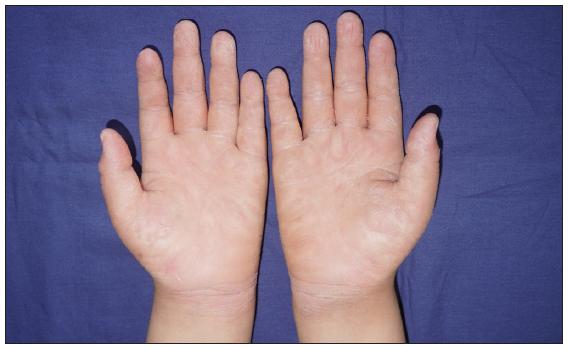
- Well-defined hyperkeratosis on both palms accompanied by scaling of II-1 in pedigree 2.
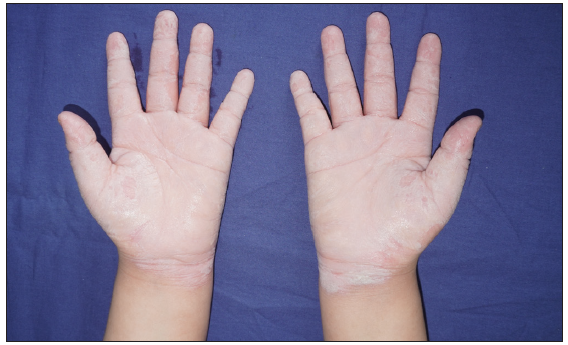
- White spongy appearance after immersion in water of II-1 in pedigree 2.
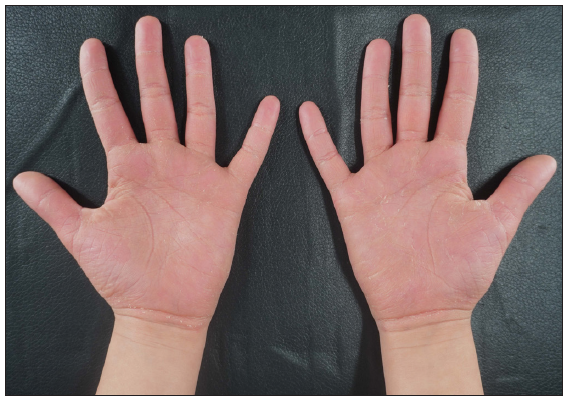
- Well-defined hyperkeratosis and erythema on both palms accompanied by scaling of II-2 in pedigree 3.
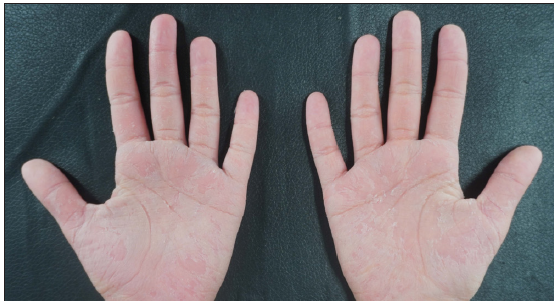
- White spongy appearance after immersion in water of II-2 in pedigree 3.
High-throughput and Sanger sequencing were performed by Shanghai Weihans Biopharmaceutical Technology Co. Ltd. [Table S1]. The sequencing results were analysed and aligned using CodonCode Aligner software. Mutations were identified utilising GATK v3.70 (Genome Analysis Toolkit). Visual sequencing chromatogram was generated using Chromas (Technelysium Pty Ltd.)
Among the 12 subjects, 10 were identified as having either heterozygous or homozygous mutations in the SERPINB7 gene, while the remaining 2 subjects did not exhibit any mutations. Notably, two patients carrying homozygous mutations (c.796C>T, the founder mutation) and two patients with compound heterozygous mutations (c.796C>T, c.336+2T>G; c.796C>T, c.455G>T) in the SERPINB7 gene all presented with the NPPK phenotype [Figure 2a-b and Figure S4]. These four cases (II-1, II-2 of pedigree 1, III-1 of pedigree 2 and II-1 of pedigree 3) were diagnosed with NPPK, potentially linked to mutations in the SERPINB7 gene. No correlation was found between genotype and phenotype across the three pedigrees.
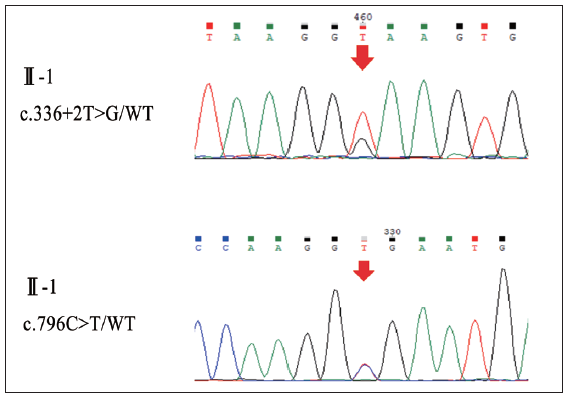
- Sequencing results of the patient II-1 in pedigree 2. Red arrows: The mutation sites.
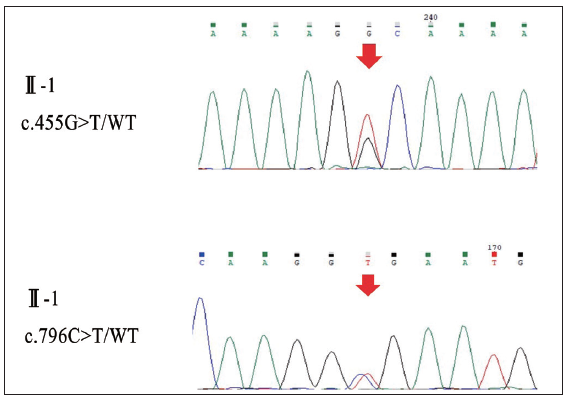
- Sequencing results of the patient II-1 in pedigree 3. Red arrows: The mutation sites.
A loss-of-function mutation in the SERPINB7 gene is implicated in the pathogenesis of NPPK.1 SERPINB7 may play a role in the expression of desmin and in the adhesion between keratinocytes. The loss of SERPINB7 function can damage desmoglein 1 and desmocollin 1, disrupting the adhesion between keratinocytes, leading to a skin peeling phenotype.2 Mutations in the SERPINB7 gene, such as c.796C>T, may result in the formation of premature termination codons (PTCs), leading to a loss of gene expression and protease inhibitory activity in SERPINB7. This loss can trigger excessive activation of proteases in the granular layer and stratum corneum, disrupting the integrity structure of the stratum corneum barrier and promoting excessive water penetration which, results in a white, sponge-like appearance.3 Serpins constitute the largest and most widely distributed superfamily of protease inhibitors, typically comprising ≥ 400 amino acids and exhibiting a highly ordered tertiary structure. They exist as a monomeric domain consisting of three β-folds (designated A-C) and nine α-helices (designated A-I) which possess highly specific conformational and functional characteristics.4 The carboxyl group of the serpin protein (P17-P50, corresponding to amino acid residues 331-352) is referred to as the reactive centre loop (RCL) which is an exposed conformational region that extends above the serpin structure. This region is crucial for docking with the reaction site of the target protease (P1-P1, corresponding to amino acids 347-348), facilitating interactions.5 The serpin behaves as a pseudo-substrate for the target protease, exhibiting substrate-like characteristics. When the target protease attempts to cleave the P1-P1’ bond, it becomes trapped in a conformational trap, resulting in the formation of a stable 1:1 docking complex with the inhibitor, thereby achieving inhibitory effects. Furthermore, recent findings have identified legumain as a key target protease of SERPINB7. The loss of SERPINB7 function leads to excessive activation of legumain which may disrupt cytoskeletal proteins and damage the skin barrier.6
This study confirms that mutations in the SERPINB7 gene play an important role in NPPK with c.796C>T (the founder mutation) identified as one of the most prevalent mutations. Furthermore, it underscores that compound heterozygous mutations in the SERPINB7 gene may contribute to the onset of NPPK. Current literature suggests that the topical application of gentamicin cream could be a potential therapy for treating NPPK-related hyperkeratosis. The proposed mechanism involves gentamicin facilitating read-through of PTCs during transcription, resulting in the insertion of random amino acids and the expression of full-length proteins, a process known as nonsense suppression. However, further research is warranted to evaluate the safety and potential for drug resistance associated with this treatment.
Ethical approval
This research/study was approved by the Institutional Review Board at the Ethics Committee of Inner Mongolia Medical University Affiliated Hospital, number Ethics No. S.2019017, dated 2019.06.17.
Declaration of patient consent
The authors certify that they have obtained all appropriate patient consent.
Financial support and sponsorship
The study was supported by the National Natural Science Foundation of China (82260619), Natural Science Foundation of Inner Mongolia (2022MS08005) and Scientific and technological innovative research team for inner Mongolia Medical University of ‘Basic and clinical research of psoriasis’(YKD2022TD030).
Conflicts of interest
There are no conflicts of interest.
Use of artificial intelligence (AI)-assisted technology for manuscript preparation
The authors confirm that there was no use of artificial intelligence (AI)-assisted technology for assisting in the writing or editing of the manuscript and no images were manipulated using AI.
References
- Nagashima-type palmoplantar keratosis with compound heterozygous mutations in SERPINB7. Case Rep Dermatol. 2020;12:241-8.
- [CrossRef] [PubMed] [PubMed Central] [Google Scholar]
- Acral peeling in Nagashima type palmo-plantar keratosis patients reveals the role of serine protease inhibitor B 7 in keratinocyte adhesion. Exp Dermatol. 2022;31:214-22.
- [CrossRef] [PubMed] [PubMed Central] [Google Scholar]
- Hereditary palmoplantar keratoderma - phenotypes and mutations in 64 patients. J Eur Acad Dermatol Venereol. 2021;35:1874-80.
- [CrossRef] [PubMed] [Google Scholar]
- An overview of the serpin superfamily. Genome Biol. 2006;7:216.
- [CrossRef] [PubMed] [PubMed Central] [Google Scholar]
- Mutations in SERPINB7, encoding a member of the serine protease inhibitor superfamily, cause Nagashima-type palmoplantar keratosis. Am J Hum Genet. 2013;93:945-56.
- [CrossRef] [PubMed] [PubMed Central] [Google Scholar]
- SERPINB7 deficiency increases legumain activity and impairs the epidermal barrier in Nagashima-type palmoplantar keratoderma. J Invest Dermatol. 2025;145:359-369.
- [CrossRef] [PubMed] [Google Scholar]





